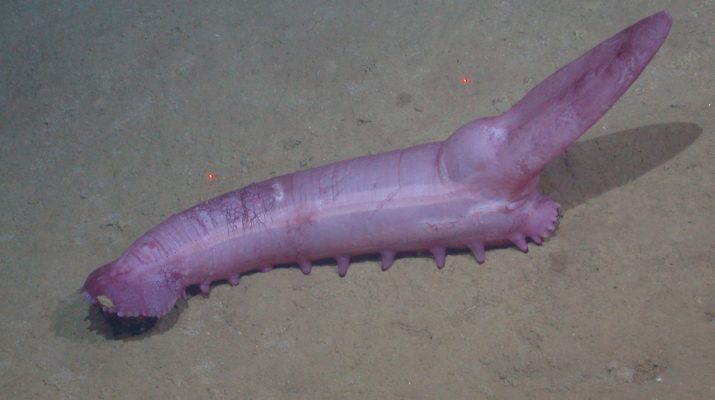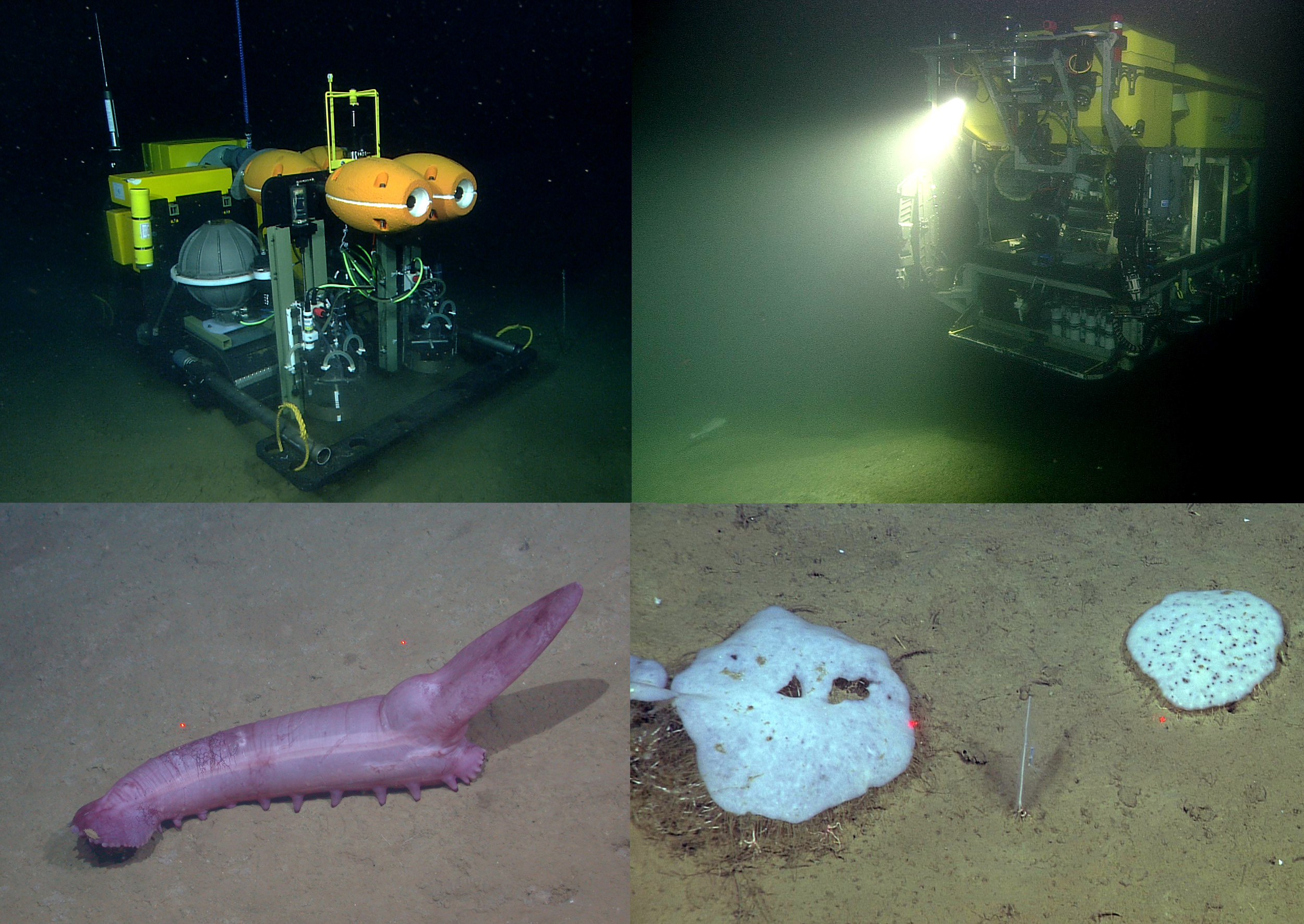[From Deep-Sea Life 15]
Henry Ruhl
MBARI, USA
In June 1989, an abyssal time-series station was established at Station M, a flat, muddy seafloor area beneath a seasonal chlorophyll-rich plume that often extends west of Point Conception over abyssal depths (about 4,000 meters). It was hypothesized that seasonal spikes in surface productivity would afford an opportunity to track this food source through the water column and identify its impact at abyssal depths. From this original plan, the study expanded to a much broader scope of monitoring inter-annual to decadal changes.
Since 1989, many research approaches have been used at Station M, including satellite imaging, water collections throughout the water column, photography and sampling of seafloor sediments and organisms, and data collection using autonomous seafloor cameras, samplers, and rovers.
When observed over time, significant changes occurred in surface water temperature and export flux of carbon at Station M. These have manifested through the water column to the seafloor. For example, between 2011 and 2018, there were pronounced increases in particulate organic carbon flux, seafloor aggregate coverage, and sediment community oxygen consumption. Changes in seafloor life and its function, from microbes to megafauna, were also studied. Such changes, along with others reported, strongly indicate a dynamic deep-sea ecosystem at Station M influenced by climate and upper ocean conditions.
- Understanding the remote influences of ocean weather on the episodic pulses of particulate organic carbon flux, H.A. Ruhl, F. Bahr, S. Henson, W.B. Hosking, B. Espinola, M. Kahru, P. Daniel, P. Drake, C.A. Edwards, https://doi.org/10.1016/j.dsr2.2020.104741
- Satellite estimation of carbon export by sinking particles in the California Current calibrated with sediment trap data, M. Kahru, R. Goericke, T.B. Kelly, M.R. Stukel, https://doi.org/10.101/j.dsr2.2019.104639.
- The two-component model coincidence: evaluating the validity of marine dissolved organic radiocarbon as a stable-conservative tracer at Station M, S.R. Beaupré, B.D. Walker, E.R.M. Druffel, https://doi.or/10.1016/j.dsr2.2020.104737.
- Temporally-resolved mechanisms of deep-ocean particle flux and impact on the sea-floor carbon cycle in the
Northeast Pacific, C.L. Huffard, C.A. Durkin, S.E. Wilson, P.R. McGill, R. Henthorn, K.L. Smith Jr., https://doi.org/10.1016/j.dsr2.2020.104763. - DNA metabarcoding reveals organisms contributing to particulate matter flux to abyssal depths in the Northeast Pacific, C.M. Preston, C.A. Durkin, K.M. Yamahara, https://doi.org/10.1016/j.dsr2.2019.104708.
- Near-bottom currents at station M in the abyssal northeast Pacific, T.P. Connolly, P.R. McGill, R.G. Henthorn, D.A. Burrier, C. Michaud, https://doi.org/10.1016/j.dsr2.2020.104743.
- Gelatinous zooplankton abundance and benthic boundary layer currents in the abyssal Northeast Pacific: a 3-yr time series study, K.L. Smith Jr., C.L. Huffard, P.R. McGill, A.D. Sherman, T.P. Connolly, S. Von Thun, L.A. Kuhnz, https://doi.org/10.1016/j.dsr2.2019.104654.
- Abyssal demersal fishes recorded at Station M (34o 50’N, 123o 00’W; 4100 m depth) in the North East Pacific Ocean: an annotated check list and synthesis, I.G. Priede, J.C. Drazen, D.M. Bailey, L.A. Kuhnz, D. Fabian, https://doi.org/10.1016/j.dsr2.2019.104648.
- Ecological insights into abyssal bentho-pelagic fish at 4000 m depth using a multi-beam echosounder on a remotely operated vehicle, K.M. Dunlop, K.J. Benoit-Bird, C.M. Waluk, R.G. Henthorn, https://doi.org/10.1016/j.dsr2.2019.104679.
- Model study of oxygen mass transfer into persistent aggregate layers in the deep sea, T.J. Shaw, C. Boucher, K.L. Smith Jr., C.L. Huffard, https://doi.org/10.1016/j.dsr2.2020.104760.
- Response of deep-sea deposit-feeding rates to detrital inputs: a comparison of two abyssal time-series sites, J.M. Durden, B.J. Bett, C.L. Huffard, C. Pebody, H.A. Ruhl, K.L. Smith Jr., https://doi.org/10.1016/j.dsr2.2019.104677.
- Insights into the ecology of epibenthic calcareous foraminifera from a colonization study at 4000 m (Station M) in the NE Pacific Ocean, A. Burkett, A. Rathburn, R.B. Pratt, M. Holzman, https://doi.org/10.1016/j.dsr2.2019.104709.
- Meiobenthos from biogenic structures of the abyssal time-series station in the NE Pacific (Sta. M), M. Lampadariou, E. Syranidou, K. Sevastou, A. Tselepides, https://doi.org/10.1016/j.dsr2.2019.104720.
- Benthic megafauna assemblage change over three decades in the abyss: variation from species to functional groups, L.A. Kuhnz, H.A. Ruhl, C.L. Huffard, K.L. Smith Jr., https://doi.org/10.101/j.dsr2.2020.104761.
- Behaviors of sessile benthic animals in the abyssal Northeast Pacific Ocean, A.S Kahn, P. McGill, S. Leyes, https://doi.org/10.1016/j.dsr2.2019.104729.
- Using metabolic theory to assess structure and function in the deep-sea benthos, including microbial and metazoan
dominance, C. Laguione Marchais, B.J. Bett, G.L.J. Paterson, K.L. Smith Jr., H.A. Ruhl, https://doi.org/10.1016/j.dsr2.2020.104762.
These papers provide a benchmark in research at Station M and in understanding deep-sea biogeochemistry and ecology. Going forward, research at the site is focused on disentangling the multiple ways in which changing surface conditions are driving deep dynamics. As human impacts become more pervasive, research at Station M and at other sites globally is helping to constrain mechanisms of biogeochemistry, biology and ecosystem function on the deep seafloor. For example, research at the Porcupine Abyssal Plain in the northeast Atlantic has also focused on addressing such issues. And, given the astounding adaptations of deep-sea life, we should be prepared for more surprises in the years ahead.


